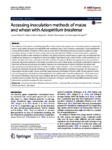Please use this identifier to cite or link to this item:
http://www.alice.cnptia.embrapa.br/alice/handle/doc/1039673Full metadata record
| DC Field | Value | Language |
|---|---|---|
| dc.contributor.author | FUKAMI, J. | pt_BR |
| dc.contributor.author | NOGUEIRA, M. A. | pt_BR |
| dc.contributor.author | ARAUJO, R. S. | pt_BR |
| dc.contributor.author | HUNGRIA, M. | pt_BR |
| dc.date.accessioned | 2016-03-04T11:11:11Z | pt_BR |
| dc.date.available | 2016-03-04T11:11:11Z | pt_BR |
| dc.date.created | 2016-03-04 | pt_BR |
| dc.date.issued | 2016 | pt_BR |
| dc.identifier.citation | AMB Express, v. 6, n. 3, p. 2-13, 2016. | pt_BR |
| dc.identifier.issn | 2191-0855 | pt_BR |
| dc.identifier.uri | http://www.alice.cnptia.embrapa.br/alice/handle/doc/1039673 | pt_BR |
| dc.description | The utilization of inoculants containing Azospirillum is becoming more popular due to increasing reports of expressive gains in grain yields. However, incompatibility with pesticides used in seed treatments represents a main limitation for a successful inoculation. Therefore, in this study we searched for alternatives methods for seed inoculation of maize and wheat, aiming to avoid the direct contact of bacteria with pesticides. Different doses of inoculants containing Azospirillum brasilense were employed to perform inoculation in-furrow, via soil spray at sowing and via leaf spray after seedlings had emerged, in comparison to seed inoculation. Experiments were conducted first under greenhouse controlled conditions and then confirmed in the field at different locations in Brazil. In the greenhouse, most parameters measured responded positively to the largest inoculant dose used in foliar sprays, but benefits could also be observed from both in-furrow and soil spray inoculation. However, our results present evidence that field inoculation with plant-growth promoting bacteria must consider inoculant doses, and point to the need of fine adjustments to avoid crossing the threshold of growth stimulation and inhibition. All inoculation techniques increased the abundance of diazotrophic bacteria in plant tissues, and foliar spray improved colonization of leaves, while soil inoculations favored root and rhizosphere colonization. In field experiments, inoculation with A. brasilense allowed for a 25 % reduction in the need for N fertilizers. Our results have identified alternative methods of inoculation that were as effective as the standard seed inoculation that may represent an important strategy to avoid the incompatibility between inoculant bacteria and pesticides employed for seed treatment. | pt_BR |
| dc.language.iso | por | pt_BR |
| dc.rights | openAccess | pt_BR |
| dc.title | Accessing inoculation methods of maize and wheat with Azospirillum brasilense. | pt_BR |
| dc.type | Artigo de periódico | pt_BR |
| dc.date.updated | 2017-06-01T11:11:11Z | pt_BR |
| dc.subject.thesagro | Fixação de nitrogênio | pt_BR |
| dc.subject.thesagro | Milho | pt_BR |
| dc.subject.thesagro | Trigo | pt_BR |
| dc.subject.nalthesaurus | Nitrogen fixation | pt_BR |
| dc.subject.nalthesaurus | Wheat | pt_BR |
| dc.subject.nalthesaurus | Corn | pt_BR |
| dc.subject.nalthesaurus | Azospirillum brasilense | pt_BR |
| riaa.ainfo.id | 1039673 | pt_BR |
| riaa.ainfo.lastupdate | 2017-06-01 | pt_BR |
| dc.identifier.doi | 10.1186/s13568-015-0171-y | pt_BR |
| dc.contributor.institution | JOSIANE FUKAMI, UEL; MARCO ANTONIO NOGUEIRA, CNPSO; RICARDO SILVA ARAUJO, Total Biotecnologia Indústria e Comércio Ltda.; MARIANGELA HUNGRIA DA CUNHA, CNPSO. | pt_BR |
| Appears in Collections: | Artigo em periódico indexado (CNPSO)  | |
Files in This Item:
| File | Description | Size | Format | |
|---|---|---|---|---|
| 135682015Article171.pdf | 1.27 MB | Adobe PDF |  View/Open |









